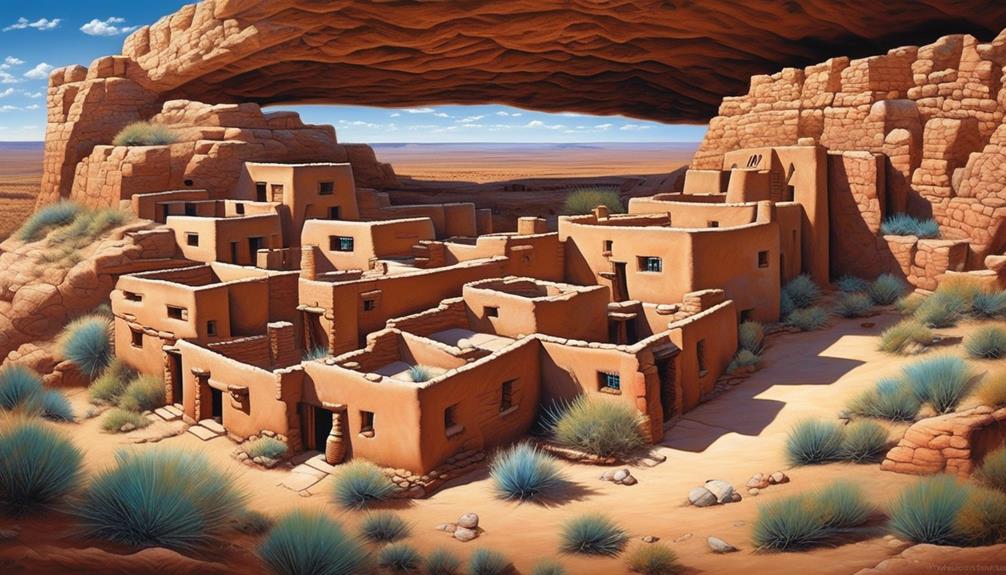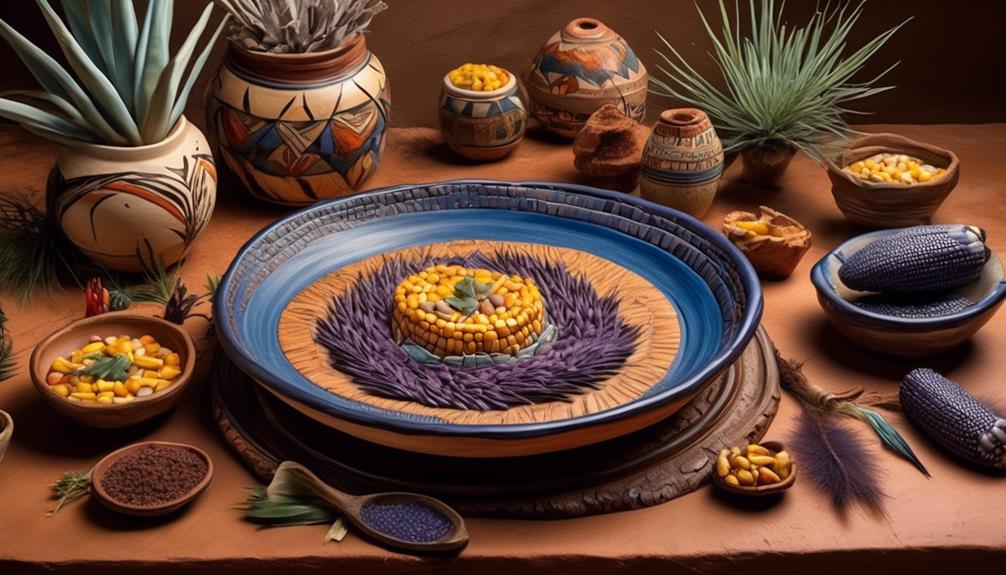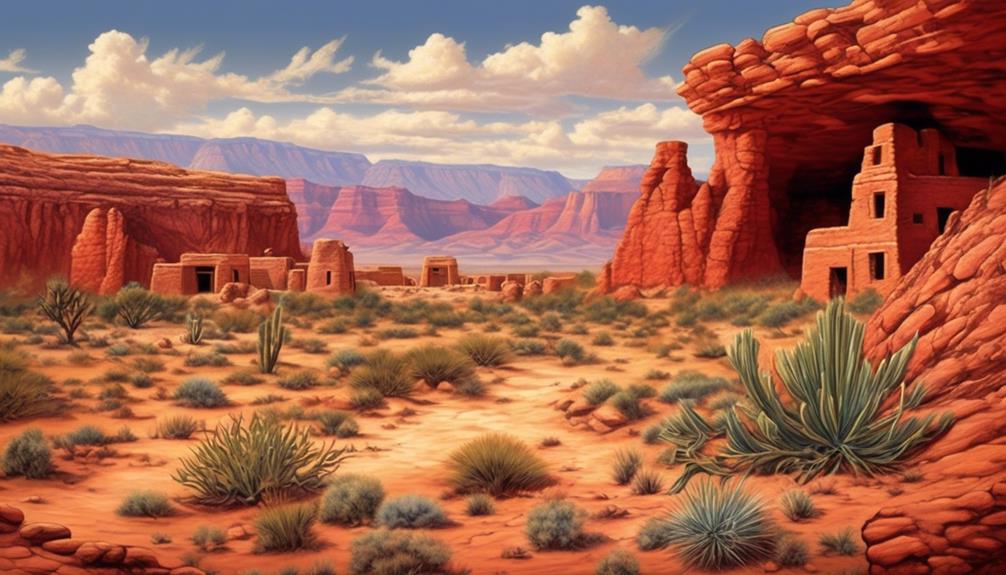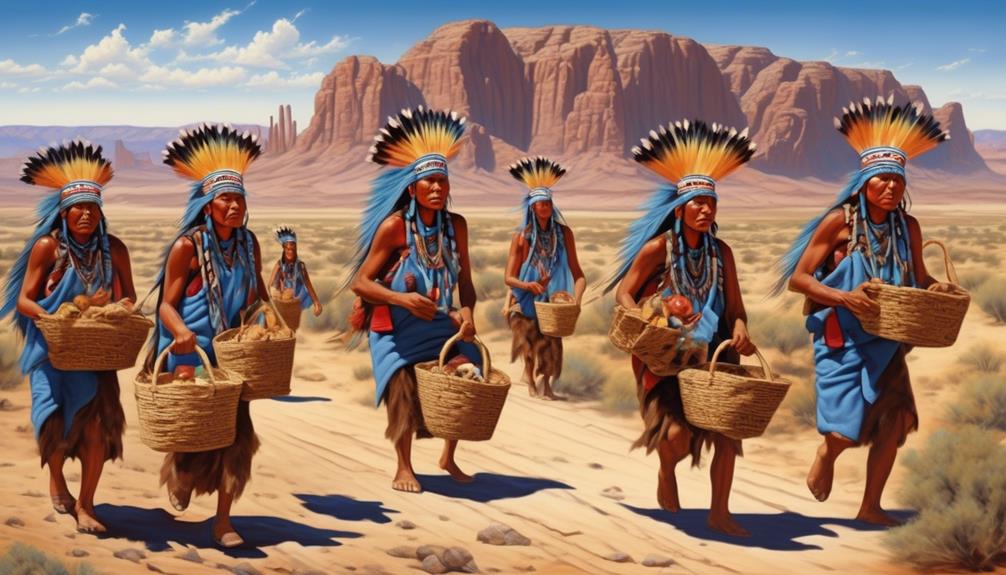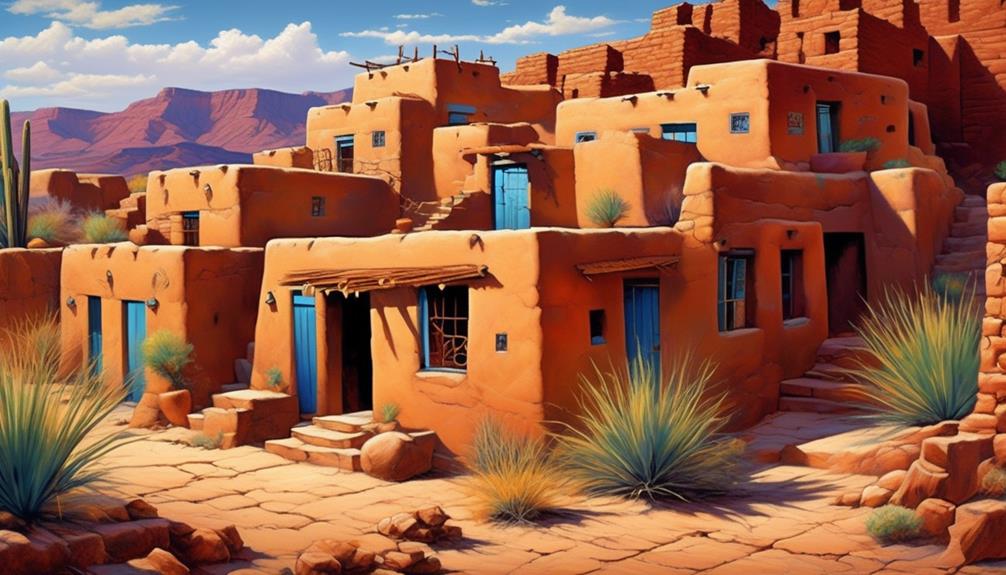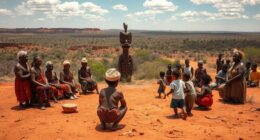When delving into the history of the Hopi tribe, it becomes apparent just how their ancient communities were expertly positioned amidst the natural scenery of the Southwest. Through the strategic placement of these settlements, we can see the Hopi people’s adaptability and gain valuable knowledge about their migration patterns.
But where exactly did they live, and how does it connect to the present-day Hopi reservations? The Hopi tribe's deep connection to the land has shaped their culture and traditions in profound ways, and uncovering the details of their historical dwellings offers a glimpse into their rich heritage.
Key Takeaways
- Hopi settlements were compact, multi-storied structures made of stone and adobe, built into the sides of cliffs for protection and insulation.
- The Hopi tribe utilized advanced building techniques and engineering prowess, as well as innovative dry farming methods using terraced fields and irrigation systems.
- The three primary mesas – First Mesa, Second Mesa, and Third Mesa – served as strategic locations for Hopi villages, offering distinct geographical features.
- Hopi migration patterns reflect adaptability and resilience, showcasing the continuity of traditions, ceremonies, and agricultural practices across different locations.
Early Hopi Settlements
In the ancient land of the Hopi, several distinct early settlements emerged, each reflecting the unique cultural and environmental adaptations of its inhabitants. The early Hopi architecture was characterized by compact, multi-storied structures made of stone and adobe, often built into the sides of cliffs for protection and insulation. These architectural marvels not only provided shelter but also served as a testament to the advanced building techniques and engineering prowess of the Hopi people.
Furthermore, the Hopi farming techniques were innovative and well-suited to the arid environment in which they lived. The Hopi perfected dry farming methods, utilizing terraced fields and ingenious irrigation systems to cultivate corn, beans, and squash. Their agricultural practices not only sustained their communities but also allowed for surplus production, enabling trade and the development of a complex social and economic system.
The early Hopi settlements weren't just places of dwelling; they were integrated with the natural landscape, embodying the spiritual connection between the Hopi people and their environment. These settlements were hubs of cultural exchange, where traditions, knowledge, and craftsmanship flourished, laying the foundation for the rich and enduring heritage of the Hopi tribe.
Locations of Hopi Villages
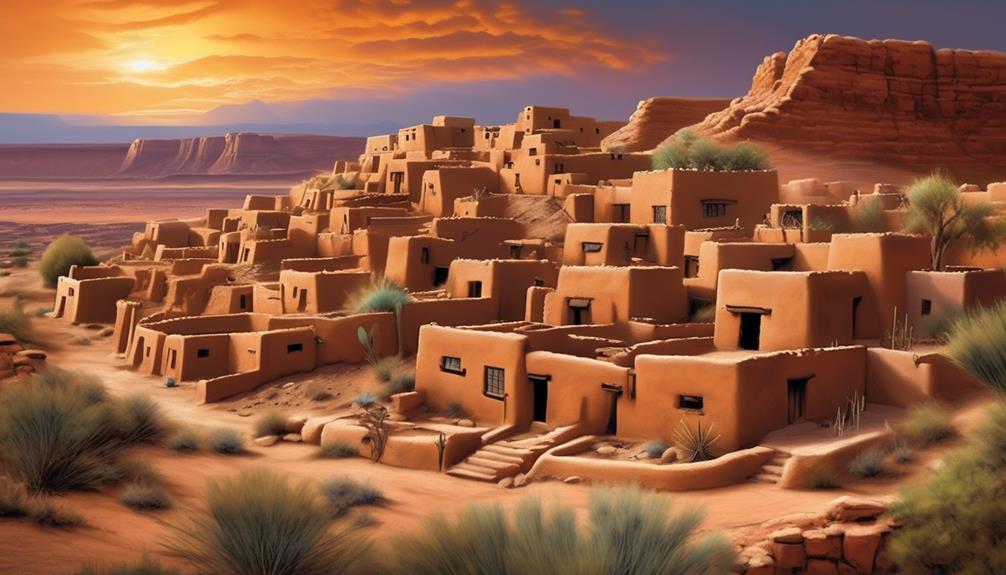
Nestled atop the mesas and within the valleys of northeastern Arizona, the Hopi villages are strategically positioned to harmonize with the natural contours of the landscape, reflecting a deep connection between the people and their surroundings.
The Hopi village sites are situated on three primary mesas: First Mesa, Second Mesa, and Third Mesa. Each of these mesas offers distinct geographical features, with First Mesa being the easternmost and having a relatively flat terrain, while Second Mesa and Third Mesa have more rugged topography.
The ancient dwelling locations within these villages reveal a remarkable understanding of the land's resources and an ability to adapt to the environment. Archaeological evidence indicates that the Hopi people have inhabited these areas for over a thousand years.
The villages aren't only positioned for practicality but also hold deep spiritual significance for the Hopi, as they believe their ancestors instructed them to reside in these specific locations. The geographical features of each mesa and the surrounding valleys have played a crucial role in shaping the unique cultural identity and traditions of the Hopi people.
Hopi Migration Patterns
Positioned atop the mesas and within the valleys of northeastern Arizona, the Hopi villages not only reflect a deep connection to the landscape but also bear witness to the intricate patterns of Hopi migration throughout history. Understanding the migration routes of the Hopi people provides insight into the cultural impact and historical significance of their movements.
- The migration routes of the Hopi reveal a profound sense of adaptability and resilience as they traversed diverse terrains, from the ancient Puebloan homeland to the mesas of Arizona. This reflects the enduring spirit of the Hopi people and their ability to thrive in different environments.
- The cultural impact of Hopi migration is evident in the continuity of their traditions, ceremonies, and agricultural practices across different locations. The ways in which they adapted to new surroundings while maintaining their cultural identity demonstrates the richness of their heritage and the depth of their connection to the land.
- Hopi migration patterns also highlight the interconnectedness of different Indigenous communities, fostering cultural exchange and shaping the collective tapestry of Native American history in the Southwest.
Studying the migration patterns of the Hopi provides a holistic understanding of their heritage, resilience, and enduring cultural legacy.
Present-Day Hopi Reservations
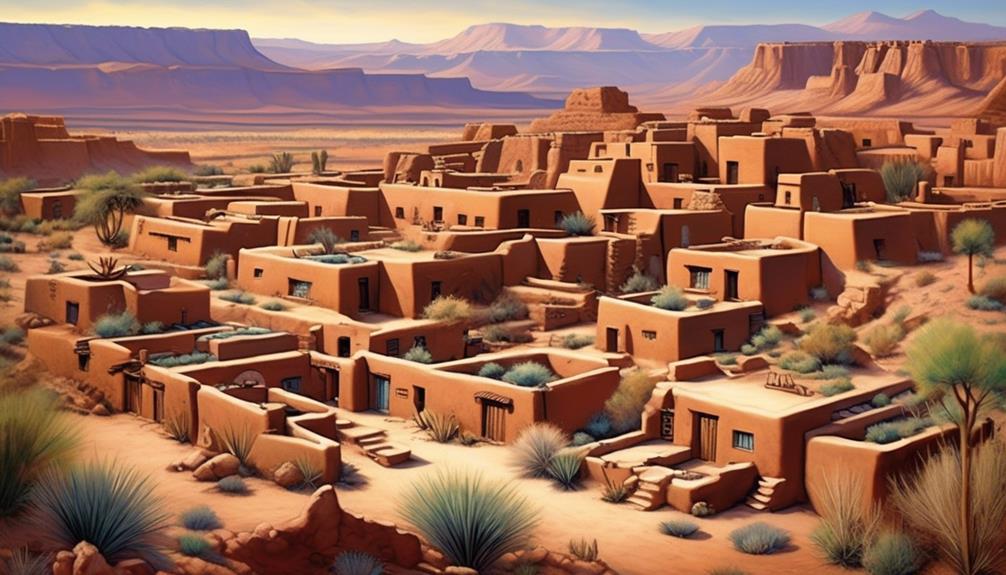
Amidst the rugged beauty of northeastern Arizona, the present-day Hopi reservations serve as vital centers of cultural preservation and community life for the Hopi people. These reservation lands, encompassing over 1.5 million acres, are not only the geographical anchor of the Hopi Tribe but also the heart of their cultural identity. The Hopi reservations are characterized by a mix of traditional and modern infrastructure, as the tribe strives to maintain its ancient traditions while embracing the necessities of contemporary life.
| Reservation | Location | Size |
|---|---|---|
| First Mesa | Northeastern Arizona | 83,618 acres |
| Second Mesa | Northeastern Arizona | 89,491 acres |
| Third Mesa | Northeastern Arizona | 89,543 acres |
| Moenkopi | Northeastern Arizona | 23,669 acres |
| Hotevilla | Northeastern Arizona | 6,948 acres |
The reservation lands provide a backdrop for the Hopi people to continue their agricultural practices, ceremonial activities, and community gatherings. Despite the challenges of preserving ancient traditions in the face of modernity, the Hopi reservations remain a testament to the tribe's resilience and commitment to sustaining their way of life.
Hopi Tribe's Connection to the Land
Indisputably rooted in the ancient soil of northeastern Arizona, the Hopi Tribe's connection to the land is integral to their cultural identity and spiritual beliefs. The land preservation isn't just a matter of practicality but a deep-seated responsibility that has been passed down through generations.
The following aspects underscore the cultural significance of the Hopi Tribe's connection to the land:
- Sacred Sites: The land is adorned with sacred sites that hold immense spiritual significance for the Hopi people. These sites aren't just physical locations but repositories of their heritage and wisdom, fostering a profound connection between the people and the land.
- Ceremonial Practices: The land serves as the stage for the tribe's ceremonial practices, which are deeply intertwined with the natural elements and seasonal changes. These rituals aren't only a means of connecting with their ancestors but also represent a commitment to preserving their land and traditions for future generations.
- Environmental Stewardship: The Hopi Tribe's connection to the land embodies a profound sense of environmental stewardship. They view themselves as custodians of the land, responsible for its preservation and sustainability.
This deep-rooted relationship with the land shapes every aspect of the Hopi people's lives, reflecting their commitment to preserving their cultural heritage and natural surroundings.
Frequently Asked Questions
What Are the Traditional Hopi Ceremonies and How Are They Performed?
Traditional Hopi ceremonies and ceremonial practices are deeply rooted in our culture. These Hopi cultural events are performed with great reverence and respect for our traditions.
Each ceremony has specific rituals and dances that are integral to our spiritual beliefs. Visitor participation in these ceremonies is limited, as they're sacred to our community.
Understanding and honoring the significance of these ceremonies is crucial for anyone seeking to engage with our culture.
What Are Some Common Hopi Traditions and Cultural Practices Still Observed Today?
Hopi traditions, like a tapestry woven with vibrant threads, continue to thrive today.
Cultural practices such as the intricate traditional ceremonies are upheld with reverence, impacting modern life and drawing tourism to our sacred lands.
Visitor participation in these ancient rituals fosters an appreciation for our heritage.
The echo of our customs resonates through time, enriching our community and preserving our identity for generations to come.
Can Visitors Participate in Any Hopi Ceremonies or Cultural Events?
Visitors can participate in some Hopi ceremonies, but it's crucial to understand visitor etiquette and participation guidelines. Cultural sensitivity is paramount when seeking ceremonial access. Respectful observation is often encouraged, but active participation may be limited to certain rituals.
Understanding the significance of the ceremonies and following the guidance of tribal elders is essential. It's a unique opportunity to engage with Hopi traditions, but always with deep reverence and respect.
How Has Modern Development and Tourism Impacted the Traditional Hopi Way of Life?
Modern development and tourism have greatly impacted the traditional Hopi way of life. The introduction of technology has brought both benefits and challenges. While it has improved communication and facilitated access to resources, it has also posed a threat to cultural preservation.
The influx of tourists has led to increased commercialization and external influence, altering the sacred nature of certain ceremonies. This delicate balance between progress and heritage is a constant concern for the Hopi community.
What Are Some Examples of Famous Hopi Art or Artisans?
Famous Hopi artists have made significant contributions to the world of Native American art. Their intricate Hopi pottery is renowned for its intricate designs and skilled craftsmanship.
The work of Hopi pottery craftsmen often incorporates traditional symbols and motifs that reflect the tribe's cultural and spiritual beliefs. These artisans have played a crucial role in preserving and promoting the rich artistic heritage of the Hopi tribe, influencing contemporary Native American art forms.
Conclusion
As we look back at the ancient Hopi settlements and their present-day reservations, we can't help but marvel at the deep connection the Hopi tribe has to the land. Their migration patterns and village locations reflect a profound understanding of the natural environment and a harmonious way of life.
The Hopi people's bond with their land isn't just a physical one, but a spiritual and cultural one that has shaped their identity for centuries.
